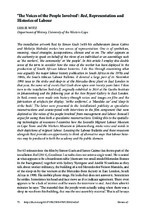| dc.contributor.author | Witz, Leslie | |
| dc.date.accessioned | 2018-05-04T12:29:07Z | |
| dc.date.available | 2018-05-04T12:29:07Z | |
| dc.date.issued | 2016 | |
| dc.identifier.citation | Witz, L. (2016). ‘The voices of the people involved’: Red, representation and histories of labour. Kronos 42: 71 - 89 | en_US |
| dc.identifier.issn | 2309-9585 | |
| dc.identifier.uri | http://dx.doi.org/10.17159/2309-9585/2016/v42a5 | |
| dc.identifier.uri | http://hdl.handle.net/10566/3638 | |
| dc.description.abstract | The installation artwork Red by Simon Gush (with his collaborators James Cairns and Mokotjo Mohulo) evokes two senses of representation. One is of symbolism, meaning, visual strategies, juxtapositions, silences and so on. The other appears as the authority to speak on behalf of the views of an individual or an assemblage such as ‘the workers’, ‘the community’ or ‘the people’. In this article I employ this double sense of the term to consider how the voice of the worker has been deployed in the production of South African labour histories. I do this through examining what was arguably the major labour history publication in South Africa in the 1970s and 1980s, the South African Labour Bulletin. It devoted a large part of its November 1990 issue to the strike and sleep-in at the Mercedes-Benz plant in East London in that year, the same set of events that Gush drew upon over twenty years later. I then turn to the installation Red itself, originally exhibited in 2014 at the Goethe Institute in Johannesburg and the following year at the Ann Bryant Gallery in East London. In Red, events were made into history through voices and images on film and the fabrication of artefacts for display: ‘strike uniforms’, a ‘Mandela car’ and ‘sleep-in strike beds’. The latter were presented in the installation’s publicity as speculative reconstructions and counterposed with interviews in the film component that were depicted as ‘the voices of the people involved’ from management and labour. Instead I argue for seeing these both a speculative reconstructions. Linking this to the spatialising technologies of museums I examine how the Lwandle Migrant Labour Museum in Cape Town and the Workers Museum in Johannesburg, evoke voice and words in their depictions of migrant labour. Locating the Labour Bulletin and these museums alongside Red provides an opportunity to think of alternative ways that labour histories may be produced in both the academy and the public domain. | en_US |
| dc.language.iso | en | en_US |
| dc.publisher | Published by History Department, University of the Western Cape | en_US |
| dc.rights | Copyright author. This file may be freely used for educational uses, as long as it is not altered in any way. No commercial reproduction or distribution of this file is permitted without written permission of the copyright holder | |
| dc.subject | Installation artwork | en_US |
| dc.subject | Red | en_US |
| dc.subject | Simon Gush | en_US |
| dc.subject | Labour histories | en_US |
| dc.title | ‘The voices of the people involved’: Red, representation and histories of labour | en_US |
| dc.type | Article | en_US |
| dc.privacy.showsubmitter | FALSE | |
| dc.status.ispeerreviewed | TRUE | |
| dc.description.accreditation | DHET | |

